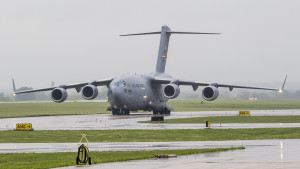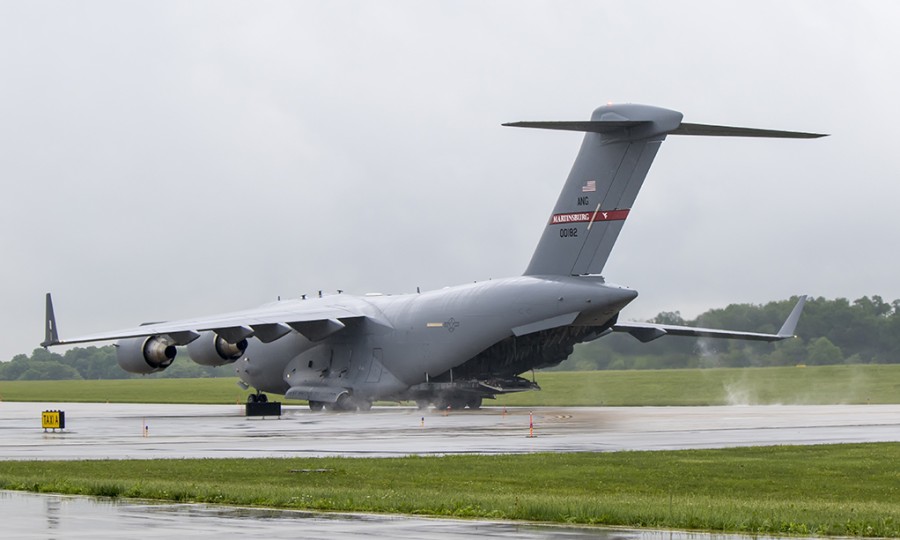The ANG 167th Airlift Wing Redefines American Exceptionalism
Article and Photos by Todd Miller
June 14, 2015
T
I visited the 167th AW anticipating insights about their recent transition from the C-5A Galaxy to the C-17A Globemaster III. As expected the professionalism at the 167th was very evident, and the transition between aircraft was moving along smoothly.
The Public Affairs (PA) team MSgt. Emily Beightol-Deyerle, 1st Lt. Stacy Gault, and service members that I encountered were (as is typically the case) professional and accommodating. I always marvel at the graciousness of the public affairs team towards journalists such as myself that by nature, force them to stand around while we never tire of taking photographs, talking to troops, and on and on. To the PA team and Airmen that allow these intrusions of camera and questions in their world, I thank-you. Although the preceding is very typical of our military personnel and easy to take for granted I sincerely express it is always noted and appreciated. However beyond the typical graciousness this visit brought me another revelation. A revelation that is American, is exceptional, and it is what separates us (and the best of the world) from the ugliness of the day. However, before I share the “epiphany,” let me fill in the story of 167th Airlift Wing.
The 167th Airlift Wing is a unit of the West Virginia Air National Guard, stationed at Shepherd Field Air National Guard Base, Martinsburg, West Virginia. Originally constituted as the 369th Fighter Squadron in December 1942, the unit has seen multiple transitions in mission and aircraft over its near 75 years of operations. Aircraft operated by the 167th AW include the P-47, P-51, C-47, T-6, F-84, F-86, T-28, C-119, C-121, C-130, C-5, and now the C-17. The aircraft operated indicate the three primary roles the unit has supported, Fighter Interceptor/Bomber, Aero Medical transport, and Airlift. A complete history of the 167th AW is available here. The transition to the mission of airlift took place in 1972, when the unit was designated the 167th Tactical Airlift Group, and assigned to the Tactical Airlift Command flying the C-130A Hercules. In 2006 the 167th AW made a “big” transition by moving from the C-130 Hercules to the largest aircraft in the US inventory, the C-5A Galaxy (for a number of years Galaxy was the largest aircraft in service in the world). At that time the base experienced quite a makeover, with new facilities built to accommodate the Galaxy.
However, as of September 2014, the last mission of the mighty C-5A was flown, and the transition to the C-17A Globemaster III was initiated. By the time of my visit May 2015, 7 of the planned 8 C-17s were already in possession of the 167th AW, and the training involved with the transition was well underway. A number of the C-5A’s had been “stored” on base for many months, with the last one departing the day before my arrival. Ultimately the fate of the 167th’s Galaxy’s bring sadness. The C-5As in the unit were the oldest in service, had not been designated for upgrades and as such were retired to the boneyard, the 309th Aerospace Maintenance and Regeneration Group (309 AMARG), at Davis-Monthan AFB, AZ. The Galaxy’s low readiness rate and high maintenance costs are almost notorious, with reports indicating the C-5 has the highest operating cost of any Air Force weapon system (see Defense Industry Daily)
Wing Commander Colonel Shaun Perkowski noted the challenge to maintain a high mission capability rate with the C-5As though difficult, was natural given their age. However it was with great satisfaction (and irony) that the last C-5A flight from Martinsburg to Davis-Monthan AFB had zero maintenance write-ups. Such a feat was a tribute to the maintenance crews at the wing, or perhaps the big bird was simply saying its final good-bye on the best of terms.
The C-17As, being much “younger” aircraft, were performing at much higher mission capability rates, which was of course very helpful to operational demands. In addition to the informal encounter with Col. Perkowski, I enjoyed the opportunity to sit down with Loadmaster Staff Sergeant Ryan Finley and Pilot, Major Nicholas Barnes. It was with these two airmen that I would realize my personal definition for what I consider to be American exceptionalism.
SSgt. Finley and Major Barnes had similar stories. Though hailing from opposite coasts (SSgt Finley from Baltimore, Maj. Barnes from Seattle), they grew up with dreams to fly, and a sense of service to be given. SSgt. Finley came from a family that had a long tradition of service in the Air Force, and inquired of active Airmen at a nearby transport base regarding opportunities. He was advised that being a Loadmaster was a fantastic position, providing the opportunity to fly, and manage critical responsibilities. SSgt Finley enlisted directly into the Air National Guard, and pursued his desire to be Loadmaster. Maj. Barnes moment came while attending college, where he found his way with a friend to a Reserve Officers’ Training Corps (ROTC) office and enlisted, making his way into the Air Force where he became a C-17 pilot.
While some pilots refer to the C-17 as a bus (albeit a sporty one given the drastic improvement in roll rate from the C-5A), the description offered by Finley and Barnes was that of “versatility.” Versatility also captures the history of the 167th given it focused on a tactical mission with the C-130, a strategic mission with the C-5A, and now both tactical and strategic missions with the C-17. The ability to move everything from Strykers, helicopters, palletized cargo or people both locally or globally keeps things interesting for SSgt. Finley. The Loadmaster is responsible to get the cargo on board, ensure the load is distributed properly, soundly secured and must also be completely familiar with the aircraft systems. SSgt Finley likens the position of Loadmaster to that of solving a Rubik’s cube. The satisfaction of getting that cargo delivered successfully was very evident, particularly in critical situations when the recipients were in dire need of the cargo.
Give us the keys to the plane, and we will go anywhere needed.”As pilot, Maj. Barnes notes that the C-17 is simply “a blast to fly.” The ability to fly short tactical ops or long strategic flights (Barnes longest non-stop flight was 14.3 hours with one air to air refueling) and land on unimproved dirt strips makes flying the C-17 not only “fun” to fly, but very interesting. A typical mission (as flown when Maj. Barnes was serving in the USAF) might see take off from Europe at an impressive maximum gross weight of around 500,000 lbs, 7 or 8 hours of flight, a mid-air refueling of some 70,000 lbs of fuel, a steep descent into an unimproved airfield (destination undisclosed). The landing is impressive given the weight of the aircraft with cargo, with the C-17 coming to a maximum stop – almost standing on its nose in only 3000 ft. At that point one can see the C-17 lumbering out of the cloud of dust kicked up by its thrust reversers, parking with the hold already open, and the loadmaster taking charge to quickly off load the critical cargo. After just minutes on the ground they are back to the unimproved strip, leaving another cloud of dust as they bounce down the unimproved strip and take the sky in a maximum climb. After another rendezvous with a tanker, the crew receives an incoming transmission that diverts them to an alternate location where a new cargo awaits. The loadmaster quickly works the math on the way so they are ready to go the moment they land. Such is the life of a C-17 crew on the fly.- Major Barnes, 167th AW
The level of career challenge, the sights seen and access to global events is something that stands with both men as an amazing benefit to the career of service. As Maj. Barnes said, “give us the keys to the plane, and we will go anywhere needed.”
Military service in today’s global environment results in combat exposure for many of our service members. Both SSgt. Finley and Maj. Barnes have flown into combat zones and been exposed to hostile fire of one kind or another. Iraq or Afghanistan, the places that most active airmen have visited immediately come to mind. As SSgt. Finley noted, you can’t prepare for combat exposure, you just do it. “When in Afghanistan we were tasked to return to a specific location. We understood the dangers there, and frankly did not want to go. But we had too; it was what was being asked of us. One just takes it in stride and does it.” Maj. Barnes added, “when flying the aircraft, you do not think about it. You just do your job, if something happens the training kicks in and you address it.” Train for the worst, operate like the best.

Rain, snow, sleet, or hail…the Boeing C-17 Globemaster III’s and the Airmen of the 167th AW can deliver
And yet those missions were not “top of mind” when each reflected on their most memorable missions. And here I found the moment of revelation, my own personal definition for what I consider to be American Exceptionalism. It was not the story of combat, of a harrowing brush with death in flight, but both men’s most memorable missions were those that contributed to a greater humanitarian cause. Maj. Barnes shared the privilege of piloting the C-17 on 3 flights from New Zealand to Antarctica at the beginning of the research season. Each flight carried some 200 people and was strictly choreographed due to the potential for rapid weather changes with no ready options for flight diversion. The flights were carefully managed to a point of no return, and finally a safe landing was made on a runway of sea ice. Who gets to do things like that? Maj. Barnes quickly continued his list of memorable missions, flights of urgency such as flying relief to Haiti after their devastating earthquakes, and bringing relief to those impacted by hurricanes Katrina and Sandy. Maj. Barnes and SSgt. Finley reflected on those flights bringing our troops, wounded or well back home, a service that brought deep meaning and satisfaction.
Without hesitation SSgt. Finley recalled his most memorable mission – flying Ebola supplies into West Africa. Though they were in and out quickly, the significance of the mission was not lost on him. They had just delivered supplies to a disease ravaged part of the world, and he had been privileged to have been part of it. SSgt. Finley had ultimate satisfaction in getting the supplies, whether humanitarian, food, water or ammunition – critical supplies, to the people who needed it.
Therein lay American Exceptionalism redefined. Granted, not limited to SSgt. Finley or Maj. Barnes, not unique to Americans, but none the less, no glory sought in taking fire, dodging missiles or carnage. No Hollywood hyped “shoot outs and car chases.” Rather than noise and bravado, to the forefront comes the underrated reward of service, of making a difference. Knowing your day’s work made another’s day better. When reflecting on the men or women in the services with whom I have had the privilege to interact, I have consistently seen, “service” resonates.
The military has brought many rewarding careers, with unique activity and opportunities all while enjoying professionals in their team and at their side. Ultimately they have been rewarded with a higher sense of service to the country and to fellow man. It is not the official definition of “American Exceptionalism” but it is exceptional, and in this case, it is American.
The Air National Guard 167th Airlift Wing, citizen airmen, exceptional Americans prepared to do any task, anywhere and anytime.
Special Thanks to the Public Affairs Team of MSgt Emily Beightol-Deyerle, 1st Lt. Stacy Gault, SSgt. Ryan Finley, Major Nicholas Barnes and the entire 167th AW.






